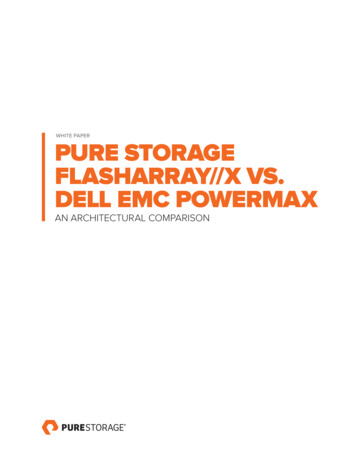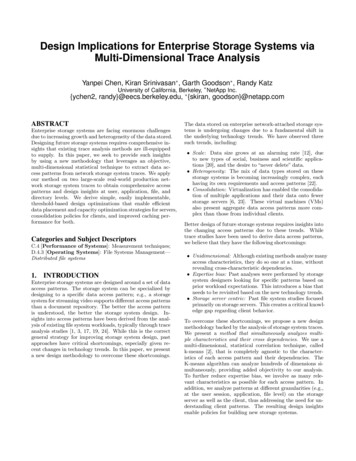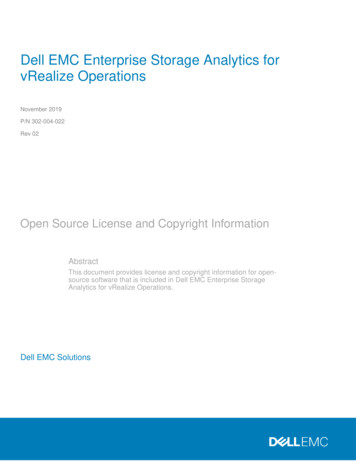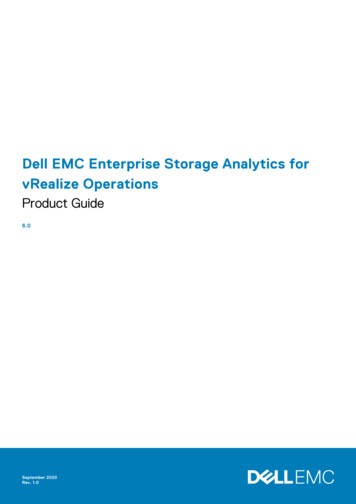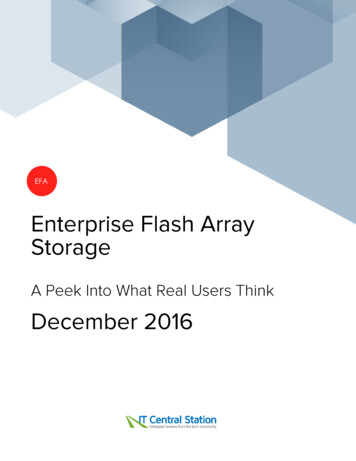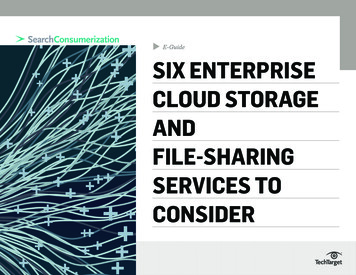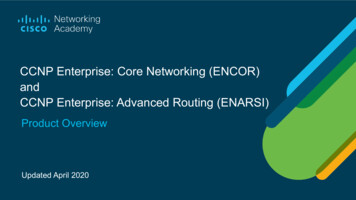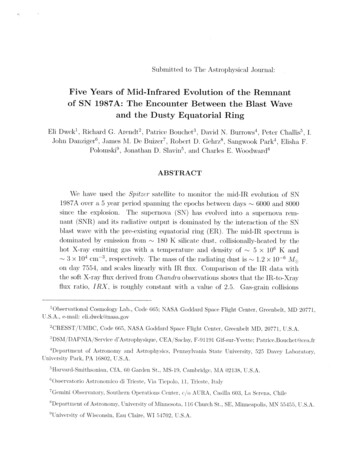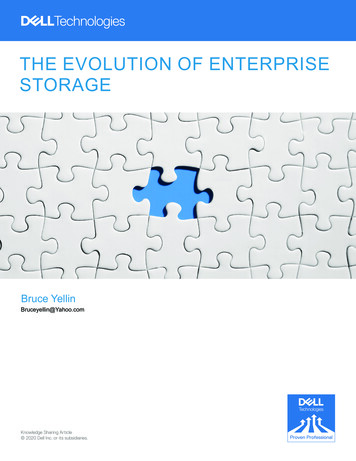
Transcription
THE EVOLUTION OF ENTERPRISESTORAGEBruce YellinBruceyellin@Yahoo.comKnowledge Sharing Article 2020 Dell Inc. or its subsidiaries.
The Dell Technologies Proven Professional Certification program validates a wide range of skillsand competencies across multiple technologies and products.From Associate, entry-level courses to Expert-level, experience-based exams, all professionalsin or looking to begin a career in IT benefit from industry-leading training and certification pathsfrom one of the world’s most trusted technology partners.Proven Professional certifications include: CloudConverged/Hyperconverged InfrastructureData ProtectionData ScienceNetworkingSecurityServersStorageEnterprise ArchitectCourses are offered to meet different learning styles and schedules, including self-paced OnDemand, remote-based Virtual Instructor-Led and in-person Classrooms.Whether you are an experienced IT professional or just getting started, Dell TechnologiesProven Professional certifications are designed to clearly signal proficiency to colleagues andemployers.Learn more at www.dell.com/certification2020 Dell Technologies Proven Professional Knowledge Sharing2
Table of ContentsEverything Must Change . 4Hard Drives Losing Ground to Solid-State Drives . 5New Shapes . 6New Interfaces . 8How Do SSDs Work? .12Anatomy of a READ .13What is a Cell? .14Enter Quadruple-Level Cell SSDs .15Quad-Level Cells look like an easy concept, but are they? .16The Big Paradigm Shift – Multi-Level NAND Cells .17Endurance Is a Big Question .18Understanding QLC Data Profiles - What Workloads Work Best? .20Intel Optane .21What’s new in storage? .22NVMe and Just a Bunch of Flash .22NVMe Over Fabrics .23A New Bottleneck – The Network .24Software-Defined Storage .26SAS-4 .28Storage Lifecycle Automation – Rebalancing SSD-based Storage .29Storage Class Memory .30Conclusion .31Footnotes .33Disclaimer: The views, processes or methodologies published in this article are those of theauthor. They do not necessarily reflect Dell Technologies’ views, processes or methodologies.Dell.com/certification3
Everything Must ChangeTwenty years ago, Windows 98 pulsed through high-end 500MHz Pentium PCs with 64MB ofmemory and a 10GB hard drive.1 Companies built three-tier architectures of servers, a gigabitFibre Channel Storage Area Network (SAN), and a “star-wars” looking EMC Symmetrix8430 machine with dozens of 36GB Small Computer System Interface (SCSI) harddrives. The 32GB cache array maxed out at 3½TB of storage and allowed access todata in cache or a much slower hard drive layer. Storage engineers designed solutionsby adding up workloads and dividing by drive capacity and Input/output Operations PerSecond (IOPs), often over-designing them to meet workload peaks. Customers flocked to SANsinstead of server-based Direct-Attached Storage (DAS) to increase utilization, reduce costs, andimprove manageability and scalability. The enterprise storage world loved it!A decade later, Windows XP used a 1.7GHz Pentium 4 PC, 80GB drive and 256MB ofmemory.2 Companies upgraded their SAN to 4Gb/s anda behemoth 10 ton, 9 rack DMX-4 with 2,400 hard drivesfor 2PB of storage.3 A revolutionary hard drive shaped73GB SCSI Solid-State Drive (SSD) dramatically boosted drive-resident applicationperformance. Each 18,000 SSD, which was comparable in performance to today’s small USBflash drive, lacked the capacity and proved too expensive to replace spinning disks.4,5Today, a Windows 10 PC runs on a 16GB 8-core processor at 3.6GHz with a 1TB SSD. On theSAN-side, data center modernization and transformation can leverage a two rack, 4PBPowerMax with a streamlined massively parallel protocol and interconnect for StorageClass Memory (SCM) and Non-Volatile Memory Express (NVMe) SSDs. Engineersnow leverage platforms with 50% more performance than the previous generation andtrim costs by sizing solutions based on effective deduplication rates. IOP performance andworkload peaks are automatically handled.6,7 Can we possibly process data any faster?While SANs are still popular, the twenty-year-old movement that freed storage from servers isstarting to come full circle. Virtualized multicore processors with fast interconnects have ledsome customers to innovative x86 Hyperconverged Infrastructures (HCI) and Software-DefinedStorage (SDS) rather than older three-tier architectures. SAN features of file, block, and objectprotocols, clones and snapshots, encryption, compression/deduplication, and replication are nolonger exclusive. SDS storage architecture can lower operational and capital expenses that2020 Dell Technologies Proven Professional Knowledge Sharing4
challenge today’s IT budgets. These new solutions incorporate SSDs in all sorts of packaging torevolutionize enterprise storage designs.Our innovative world is full of change. From a technology perspective, while hard drives,mainframes, and magnetic tapes are still in use, the pace of change has increased. Similarcapacity and performance of a high-end circa 2000 Symmetrix can be found in an enterpriseserver at a fraction of the cost. Just 6 layers of a 96-layer NOT AND (NAND) logic gate chip canhold the contents of a large 10TB hard drive.8 (NAND chips are SSD building blocks andcovered in detail later on.)Computer storage is on the precipice of yet another shift. Moore’s Law is being kept alive withnew types of storage that doubles the performance while halving the cost. The enterprisestorage world is constantly evolving and this paper is about those elements of change.Hard Drives Losing Ground to Solid-State DrivesThe annual hard drive unit growth rate is in decline. Worldwide hard driveshipments slipped 2.5% annually from a 370 million unit peak in 2018 to330 million in 2021. Meanwhile, SSD shipments increased 13% annually to360 million units.9 High performing 15K RPM hard drives hold 900GBwhile large capacity 20TB hard drives run at 7,200 RPM, both smaller andslower than large high-performance SSDs.10,11 Systems needing fast response and high transferrates now use SSDs instead of 10K-15K RPM drives while applications such as videosurveillance still use lower-performing, lower cost 5,400-7,200 RPM units.12 While the market forolder hard drive technology is shrinking, 240 exabytes of rotating platters shipped in Q3 2019.A decade ago, some programs that used four hard drives for capacitynow use one high density, high throughput dual actuator Heat AssistedMagnetic Recording (HAMR) 20TB drive as shown to the right. Twoactive heads double the IOPS and performance to 480MB/s for lesscritical applications and high-performance secondary workloads. Seagate is planning a new100TB HAMR drive for 2025.13,14Just two decades ago, a 500,000 storage rack held a few terabytes of data. Concurrent accesswas limited to a handful of small SCSI hard drives while consuming many kilowatts of powerand dissipating thousands of BTUs of heat. SSD innovations such as Triple-Level Cell (TLC)with a 128-layer 1Tb die (a rectangular integrated circuit sliced from a circular wafer) arehappening faster than hard drive improvements. Breakthroughs with lower cost 144-layer QuadDell.com/certification5
Level Cell (QLC) 2½” SSDs and future 176-layer QLC SSDs could yield a 120TB hard driveform factor.15,16 Without a rotating platter, SSDs can take on different shapes, allowing thirty-two170TB SSDs with a new shape to deliver 5PB of storage in a 1U server or 217PB in a full rack.This density/performance improvement helps close the SSD/hard drive price gap.Motorized hard drives limit performance. I/O commands queued against fragmented dataexperience higher latency due to increased head movement and rotational delay, resulting infewer IOPS and lower throughput. Latency, similar to the occasional lag between a TV videoand voice, critically represents the delay in programs getting I/O responses. Amazon equates100ms of latency with a 1% web sale loss.17 SSDs do not have mechanical issues and easilyhandle parallel low latency commands, making them ideal replacements for aging hard drives.Lastly, hard drives seem to fail at a higher rate than their counterparts, although it is worthnoting that SSDs also wear out as we will discuss. The idea of critical components wearing outis not new; after all, our cars have a spare tire for a reason.New ShapesIt helped early SSD product adoption to use the familiar 2½” rectangular hard drive shape and fitinto existing drive slots. They used the same interface such asSCSI (introduced in 1981), Serial Advanced TechnologyAttachment (SATA), Serial Attached SCSI (SAS), and PeripheralComponent Interconnect Express (PCIe).18 This illustration showsthe shape of a 2½” QLC SSD is identical to a SCSI hard drive.A U.2 drive represents the next phase of hot-swappable SSDs using a hard drive shape. It usesthe same SAS/SATA connector although the pinouts carry different signals19. Whereas theSAS/SATA connector maps to a drive controller which then interfaces with PCIe, U.2 drives donot require a controller and use the connector to map directly to a PCIe connection.M.2 SSD cards were originally called Next Generation Form Factor (NGFF). The M.2 2280(22mm x 80mm) is the size of a pack of chewing gum. Unlike.87”2½” enterprise SSDs, M.2 is not “hot” replaceable. They requirethe computer to be turned off since they plug into a dedicated3.15”motherboard slot (or PCIe adapter card) and are not insertedfrom the front of the machine. The cards scale up to 2TB ofcapacity and lack a protective case. With the same general SSD circuitry but in a narrow formfactor, they are available with a SATA or a four-fold faster NVMe interface.202020 Dell Technologies Proven Professional Knowledge Sharing6
New SSD shapes allow for smaller and more powerful servers by packing more NAND die ontocircuit boards for denser capacity. With improved power efficiency and thermal profile, theylower the effective cost per gigabyte and allow for new architectures. One radically disruptiveshape is called Enterprise & Datacenter Storage Form Factors (EDSFF) or “ruler” for short.Storage rulers come in a short (EDSFF E1.S) and long size (EDSFFE1.L). Short rulers resemble M.2 drives and plug into the front of aserver and support hot-swapping. Just 32 long rulers with denseQLC NAND give a server almost a petabyte of SSD storage in justone rack unit (1RU) asshown to the right.21These designs are a clear change in data centerremovable storage versus the airflow and circuitboard size limits of 2½" SATA, SAS, and U.2 driveform factors.The illustration on the right shows the height and width of these new rulerSSDs versus 2½” thin, 2½” regular SSDs, and large capacity 3½” harddrives. Some 1U servers accommodate a mix of rulers and U.2 drives byhousing them in swappable independent sleds as shown to the left. Using 32hot-swap U.2 NVMe drives in a removable deepmodular enclosure and 16 hot-swap storage rulersin a removable modular enclosure, the server provides 1PB of storagespace.In this scaled drawing, 24 U.2 SSDs (0.7PB)fit in 2U of rack space while 64 EDSFF rulers ( 2PB or 2.6X denser) fits into the same space.If you compare the ruler to 12 x 4TB 3½” harddrives in 2U, the ruler is 46X denser. A full42U rack of hard drives holds 903TB while arack of rulers is about 41 petabytes, orconversely, the entire rack capacity of 3½” harddrives could be reduced to a single 1U of rulers. Compared to 2-millisecond latency for a 15Khard drive, any EDSFF can READ 3,200 MB/s and WRITE 1,600 MB/s in 135 microseconds.22Dell.com/certification7
Four additional form factors were designed by the EDSFFWorking Group. The EDSFF E3 comes in a long 3½” and a short2½” drive depth in either a 7.5mm (about laptop drive size) or16.8m
server and support hot-swapping. Just 32 . long rulers. with dense QLC NAND give a server almost a petabyte of SSD storage in just one rack unit (1RU) as shown to the right. 21. These designs are a clear change in data center removable storage versus the airflow and circuit board size limits of 2½" SATA, SAS, and U.2 drive form factors.

